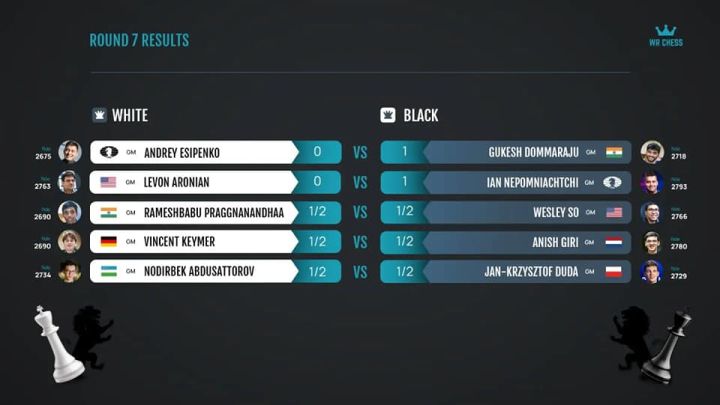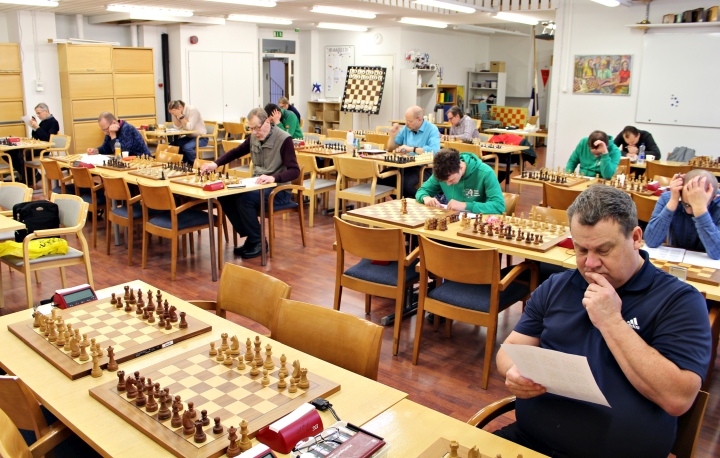WR Chess Masters Round 7: Gukesh catches up with Aronian

Gukesh has caught up with Levon Aronian. After a Black win over Andrey Esipenko in the seventh round of the WR Chess Masters, the youngest competitor now shares the top spot with the oldest on 4.5 points. The two will meet in the ninth and final round, potentially a showdown for the tournament title. Heading for a showdown to win the tournament? Gukesh, twice. | Photo: Lennart Ootes Aronian lost to Ian Nepomniachtchi, who managed to break his run of drawn games. With four points from seven, the upcoming World Championship finalist is hot on the heels of the two leaders and in a good position to win the tournament himself. Levon Aronian’s queen had lost its way a bit on the wing named after it with no discernible task and no quick way back, one reason why Nepomniachtchi was satisfied with his position early on. Alone: he had used up a lot of time. On the other hand, the exposed position of the opponent’s queen gave him the opportunity to chase it back and forth, thus repeating moves without changing the position. After the first back and forth, Aronian suddenly called arbiter Gregor Johann to the board and claimed a draw because of a threefold repetition. But Aronian had miscounted. Johann ordered the game to continue. When Ian Nepomniachtchi realized how much Levon Aronian wanted a draw, he decided to play on and was rewarded. | Photo: Lennart Ootes “When Levon even went for the arbiter to get a draw, I saw how big his desire for a draw was,” Nepomniachtchi explained after the game. And he named another argument to continue the game: “I don’t have so many classical games before the World Championship match. I should use them.” And how he used this one. With the white queen locked out on the other wing, Nepomniachtchi launched an attack against the under-defended white king. Gradually, he managed to bring more and more forces into position against Aronian’s monarch. After Aronian missed one or two opportunities to raise counterplay, the black initiative became irresistible. Form exchange: There was a form on the board that started at move 61, not move 1. Arbiter Thsepiso Lopang corrected the matter. | Photo: Lennart Ootes The second Black victory, not only of the round but of the tournament, came to Gukesh, although it didn’t look like it at first. In a Catalan gambit, the Indian was on his own early – unlike his opponent. “He’s prepared, it’s probably quite dangerous for me,” Gukesh reflected during the opening. “But I’m proud of what I then found on the board.” A knight move that was actually offside looked terrible at first glance but was tactically and strategically justified in these specific circumstances. Nevertheless, it looked as if Esipenko was gradually organizing a promising king attack. But Gukesh coolly fended off what came, and he was still playing on the other side of the board with the extra pawn Esipenko had sacrificed at the start of the game. The white attack petered out, and the black counterattack soon took hold. Wesley So and Praggnanandhaa provided the marathon of the day. For over seven hours, So pressed for the full point with the black pieces. The Indian defended flawlessly in the rook ending until after 82 moves, there was only one rook each left on the board. The most spectacular game of the day seemed to be played by Nodirbek Abdusattorov and Jan-Krzysztof Duda. Already on move seven, Black’s king had to flee to g6 into the open field, but one move later, a black knight snatched a white rook on h1. But what looked wild and hardly transparent was known to both players. Both had embarked on a rare line of the Steinitz Attack in the Petrov Defense, and both knew exactly what they were doing. The spectacle soon petered out into a roughly even endgame. Pawn c4? Sebastian Siebrecht provides guidance to Düsseldorf’s head of sports Britta Zur on how to execute the ceremonial opening move. | Photo: Lennart Ootes Vincent Keymer and Anish Giri also had such an endgame on the board very early on. Keymer claimed possession of a pawn, Giri had greater activity and a better pawn structure. The result was an even game. More photos and interviews in the tournament feed Text: Official website Photo: Lennart Ootes Offical website: wr-chess.com/
Wissmann wins in Finland, solvers move to Poland and Netherlands

The 44th Finnish Championship in solving took place in the Chess Arena in Helsinki. The longtime director of the competition, Neal Turner, carefully selected the 12 problems to be solved within three hours. In solving competitions, the problems should not be just challenging; they must be of good quality, showing interesting and original ideas in an artistically satisfying way. The chosen problems met all these requirements, so Neal Turner did an excellent job! All 18 participants received points for their solutions and were also able to enjoy the beauty of chess compositions. Take, for instance, this mutual firework in two moves only: Mate in 2 moves The selection included two problems of each type: 2# (mate in two moves), 3#, more-movers (mate in four or more moves), endgame studies, helpmates and selfmates. The top finishers were close to the maximum of 60 points. For every correct solution, a solver received five points, but it was difficult to find all variations in the allotted time. Those who think a helpmate is easy to solve because Black helps to be mated may try the following problem from the competition in Helsinki: Helpmate in 2 moves (4 solutions) Black plays first and cooperates to be mated in the 2nd white move. As usual in helpmates, there are more intended solutions as parts of the overall concept. There is a powerful white battery Qa2-Nc4, suggesting it should be used for the mating move, but it gets paradoxically abandoned each time to create four other batteries. One of the solutions works this way: 1.Qb4! (Black has to take care of his own checking battery Qc5-Kd5) Rb3! 2.Kxc4 Rc3#. Can you find the other three solutions? In the close contest for the top honours, five solvers managed to score more than 50 points. Dutch GM solver Dolf Wissmann missed only 1.5 points and emerged as a deserved winner, ahead of two other GMs, Martynas Limontas of Lithuania and Jorma Paavilainen of Finland, who shared the 2nd place. Both netted an equal number of points and used the maximum time, but for the ex-World champion in solving Jorma Paavilainen, that was enough for the 11th domestic title, bringing him closer to the record holder with 14 Finnish titles, the multiple World Champion Pauli Perkonoja. Jorma Paavilainen (2nd-3rd), Dolf Wissmann (1st) and Martynas Limontas (2nd-3rd) Experienced Finnish IM Kari Karhunen, the holder of ten Finnish titles, finished only one point behind this duo, followed by the rising Lithuanian talent Kevinas Kuznecovas. Vidmantas Satkus, on the 6th place, rounded out a great performance by the Lithuanian squad. The youngest participant Kevinas Kuznecovas (18), was by far the fastest of all 18 solvers in Helsinki, using only 142 minutes. However, being that fast, he missed 5 out of 10 possible points in two endgames. For the maximal score in the following endgame, the solvers had to find all 13 White’s moves in a surprising King’s corner-to-corner walk! White to play and win Final standings: 1. Wissmann 58.5 points (166 minutes), 2-3. Limontas and Paavilainen 57 (180), 4. Jarhunen 56 (180), 5. Kuznecovas 54 (142), 6. Satkus 46 (180), 7. Tanner 43.5 (180), 8. Mockus 35 (180), etc. Is my solution correct? The strong Lithuanian team The best six solvers significantly rose in the overall standings of the World Solving Cup 2022/23: 1. Martynas Limontas (LTU) 29 points (+10 points), 2. Kevinas Kuznecovas (LTU) 17 (+4), 3. Arno Zude (GER) 16, 4. Dolf Wissmann (NED) 13 (+13), 5. Vidmantas Satkus (LTU) 12 (+2), etc. The next legs of the WSC 2022/23 will be the open championships of Poland (Sekocin Stary, March 4-5) and the Netherlands (Nunspeet, March 4). Solutions: Position 1 (Vjacheslav Kamenskij)1. Rg6! Position 2 (Fadil Abdurahmanovic)1.Qb4 Rb3 2.Kxc4 Rc3#1.Q×d4 Qb1 2.Ke4 R×d4#1.Qd6 Rc3 2.Kc6 Na5#1.Qe7 Qxb2 2.Ke6 d5# Position 3 (Aleksander Maskimovskic, Yu. Makletsov)1.Re7+ Kh8 2.Re8+ Kxh7 3.Rxe4 Ra1+ 4.Kxa1 bxc2 5.Re7+ Kh8 6.Rh7+ Kg8 7.Bc4+ Kf8 8.Rf7+ Ke8 9.Bb5+ Kd8 10.Rd7+ Kc8 11.Ba6+ Kb8 12.Rb7+ Ka8 13.Rb1 All 12 problems from the 44th Finnish solving championship Solutions with the distribution of the points Text: Marjan Kovačević, WFCC President Photos: Hannu Harkola Official website: wfcc.ch/
UPDATE: Fair Play Commission on the Carlsen/Niemann Report

On February 17, the Fair Play Commission (FPL) unanimously adopted the report on the Carlsen/Niemann incident drafted by the Panel tasked with investigating the case, composed of Klaus Deventer (chair), Vincent Geeraets and Salomeja Zaksaite. On February 20, the 30-page report was forwarded to the Ethics and Disciplinary Commission (EDC) for further consideration. EDC’s nominated panel will assess the FPL’s findings and reach a decision on the case within six weeks. Pursuant to Art. 5 of the EDC Procedural Rules, until a decision is made, the contents of the Report shall be kept confidential to protect the procedure itself and all interested parties. Until then, no further comment on the matter shall be released by any FPL, EDC member, or any other FIDE official.

